
Musk could learn a lot from Kinney.
It appears that the Fort Lauderdale City Commission is moving forward with the futuristic plan for the Elon Musk tunnel from downtown Fort Lauderdale to the beach. As previously written here, this is disturbing on several grounds, not the least of which is that few people support what seems a highly problematic concept. The Sun-Sentinel quoted one citizen who objects to the tunnel as saying she knows no one who thinks it is a good idea. Second that thought. I don't know anybody either. In fact, with newspaper readership in decline, one wonders how many people even grasp the concept.
At first glance, the idea of a tunnel to relieve the traffic bottleneck leading to the Las Olas Boulevard's access to the beach seems praiseworthy. That is, if it were a real tunnel — one in which people could drive their cars under the existing problem, much the way the Henry E. Kinney Tunnel takes U.S. 1 drivers under the New River. But I wonder how many people understand this is not that kind of tunnel. This is a special design used to accommodate only special Tesla vehicles. It is a good idea for connecting an airport to a nearby population center or mass transit facility. It is a fast version of a bus between two points. But the current traffic problem is not one that buses or any form of existing mass transit can solve. If it could, the problem would be solved already.
Rather, the problem is people who need to drive their own cars. If those people were all going to the Brightline station (the proposed western terminus) or to the Elbo Room on the beach, it would be one thing. But that traffic consists of people going all over the beach at one end and in countless directions from downtown at the other. They need their cars to complete their trips. What are they supposed to do — rent a car after they leave the tunnel?
Common sense tells us the tunnel users would largely be tourists, and they aren't the obvious source of the congestion. You would think the first thing the city would do is survey those now causing the traffic problem, to find out where they are going and whether they would use the tunnel. Do this before any money (and nobody knows how much) is spent planning and executing the novel Musk concept.
At the same time consider the feasibility of a real tunnel between downtown and the beach. As written here before, it could be much shorter, and presumably a lot cheaper, connecting Broward Boulevard to the beginning of the Las Olas Isles, either beneath the very busy 15th Avenue (where the worst gridlock occurs) or from the point where Broward turns north into Victoria Park Road, and then just four blocks south under the existing canal to Las Olas.
You could call it the McCormick Tunnel. if Musk wants to build it, add his good name to the project.
Photo credit: formulanone from Huntsville, United States, CC BY-SA 2.0 <https://creativecommons.org/licenses/by-sa/2.0>, via Wikimedia Commons
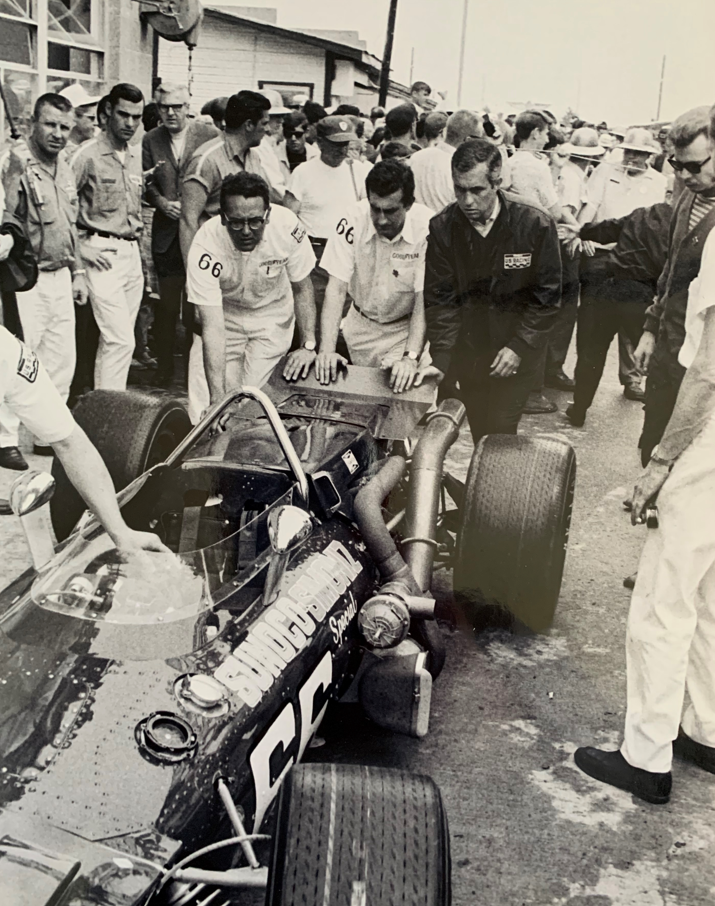
Roger Penske was a hands-on manager. He helps push his racer to the garage. (Bernard McCormick carried an early pocket camera. His photos accompanied his story.)
Alan Halpern, editor of Philadelphia magazine, was not a big sports fan. But he knew many of his upscale business audience were, and one of the reasons he hired me may have been my background as a newspaper sports writer.
In any event, the magazine began doing sports articles in the mid-1960s. We went to Florida for spring training with the Phillies when Gene Mauch was the innovative manager and Dick Allen its star hitter. We spent time with the Eagles during one of its less memorable fall seasons, and later traveled with the 76ers when they had a championship team with star Wilt Chamberlain. We visited Canada pre-season to welcome the Flyers bringing big time hockey to Philadelphia, and went out on the water with Philadelphia's Vesper Boat Club after they had won the Olympic eight race.
Halpern also cooperated with the ad boys to attract business, and thus it came to pass that we lucked into a story on a local boy with big promise in auto racing. Having bought a Porsche (only $2,600 — used but in great condition), I had an interest in sports cars. You would not mix that car up with later Porsches. It had only a 90 horsepower rear engine, but it was great fun to drive and impressed people who knew what a Porsche was. The German firm had just entered the U.S. to compete for the youth market with British sports cars such as MG, Triumph, and Austin-Healey.

McCormick drove a used 1958 Porsche at a time when its now-familiar shield logo was little known in the U.S.
Roger Penske’s name had been mentioned in the Philadelphia papers since he began racing while still at Lehigh University. He became one of the best drivers in the sports car field, driving various cars including a Porsche. He did this while entering the business world. He stayed close to cars, first as manager of a Philadelphia Chevrolet dealership, then as the owner. Although he gave up driving, he managed a sports car team which had great success with a young driver named Mark Donohue. By 1969 their reputation was enough to warrant serious press when they announced they were going to take a big step up by entering the biggest race of all, the Indianapolis 500. It was a new form of racing, an oval track, much different from the serpentine, undulating sports car venues with their constantly changing speeds. Sports car racing had a limited fan base, whereas Indy was one of the great events in sports, attracting live crowds in the hundreds of thousands.
For Philadelphia magazine, it was a made-for-order story. It involved cars, whose advertising we sought. It focused on a young local man rising in business who had shown his acumen by landing Sun Oil as his principal sponsor. That firm was a local giant whose office was just around the corner from the magazine, and its PR man was a friend from the newspaper business.
Roger Penske could not have been more cooperative. Although I had owned a Porsche, I had never seen an auto race of any kind. I probably told Penske that, and he gave me a pretty good education. I visited his racing headquarters in suburban Philadelphia, and the facility where his novel four-wheel drive Lola was being prepared. I made several trips to Indy, including the rookie qualification weekend, and flew in Penske’s rented plane.
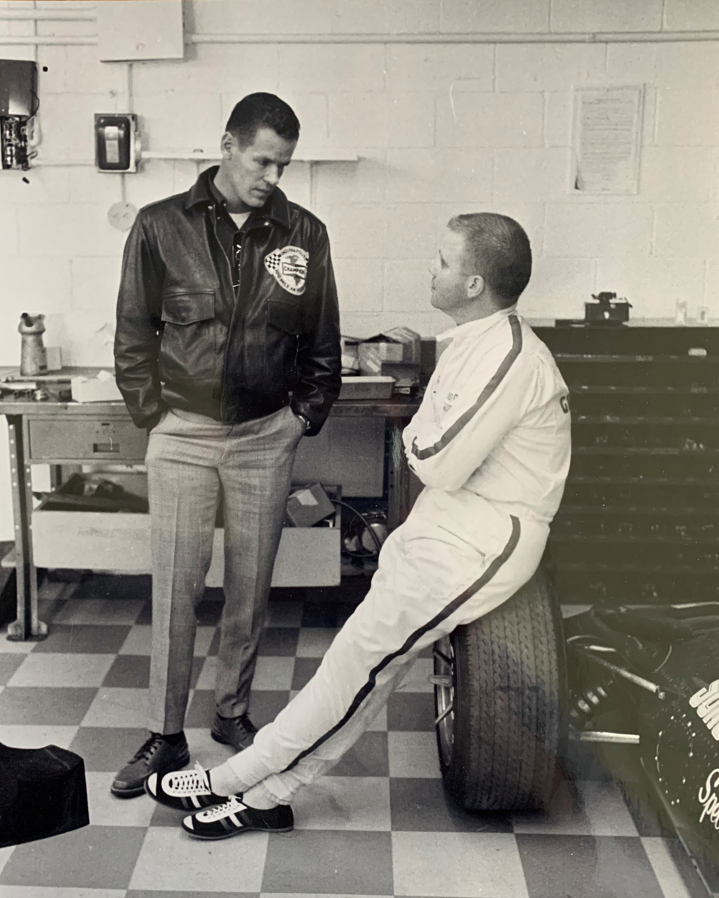
The team’s garage was a parade of reporters and racing notables. Bobby Unser, who had won the previous year, visited Mark Donohue.
Penske and Donohue commanded remarkable attention for newcomers. Their garage, which he kept immaculate, was constantly crowded with reporters and prominent racing figures. Compared to typical Indy teams, they were viewed as college boys from elite schools. (Donohue had an engineering degree from Brown.) They both already had nicknames. Our story was titled “Captain Nice and Mr. Clean at Indy.” Penske’s obsession with neatness and detail and Donohue’s soft-spoken and pleasant style preceded them.
After qualifying with a fast time, their car started in the second row, and was running third when an engine problem cost them time in the pits and led to a sixth place finish in a race won by Mario Andretti. Penske’s work did not end that day. I wanted one more visit with him and he met me the day after he returned to Philadelphia in his office — at 7:30 in the morning. He was signing 130 thank-you letters that had been prepared in advance. He said it did not take much time and people appreciated it. One sensed a man destined for distinction.
Penske had estimated it would take them three years to win at Indy; he was off by a year. Donohue won in 1972. His career and very close relationship with Penske ended when he died in a practice accident three years later in Graz, Austria. A blown tire sent him into a track barrier. He did not appear to be injured. He complained of a headache and died the next day from a brain injury. Roger Penske went on to win a record 18 times at Indy with various drivers and car manufacturers. Nobody else is close. His work off the grid has been just as impressive. His company owns various businesses, including truck leasing, collision centers, hundreds of auto dealerships (a number of which are in Florida), and even a media company. His companies reportedly employ over 60,000.
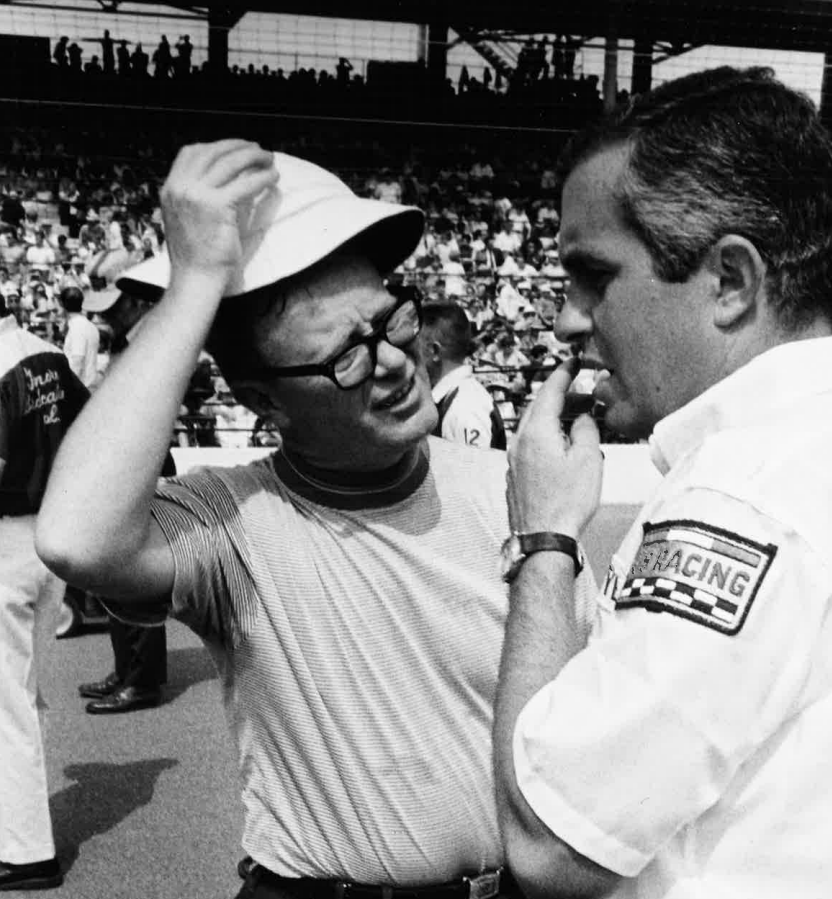
Penske had a deft and gracious touch with the media. He is interviewed by Philadelphia columnist Sandy Grady.
In recent years his empire included a special acquisition. In 2019 he purchased the Indy 500 and the IndyCar series. His development of the Indy 500 was delayed by the Covid epidemic, limiting the size of its Memorial Day crowds, but this year it was back on track with 300,000 in attendance. I have tried to watch the Indy 500 every year since that memorable 1969 race, rooting for another Penske winner. But last Sunday was special, with the race celebrating its new owner. Roger Penske, still active at 85, gave the storied command: “Drivers, start your engines.”
My thoughts went back 53 years to that weekend in Indianapolis. One of the numerous sports writers following his team marveled at all the fuss being paid to this impressive newcomer to auto racing’s biggest event. Watching Penske’s poise while being interviewed by a national TV figure, he dropped a comment.
“You would almost think he owned the place.”
Did you know that after more than 20 years of investigation, the FBI recently released files revealing that important Saudi Arabian government figures, including religious leaders in the United States, were behind the 9/11 attacks?
You didn't?
Well, you will pretty soon — as soon as someone in our mainstream press realizes those FBI reports exist and publishes the explosive information.
Meanwhile, if you can't wait, look up the Florida Bulldog website and Dan Christensen's discovery of the FBI report, which appeared in March, buried in voluminous documents released by the bureau. That hardly seems accidental.

At least it would not seem accidental to Christensen, who has been on this story since 2011. He and a few others uncovered information on the source of the 19 hijackers financing long ago, and challenged the FBI repeatedly to reveal what it failed to tell the 9/11 Commission when it published its investigation in 2004. Christensen's main contribution was finding links to a highly connected Saudi Arabian who was living in Sarasota and had ties to the hijackers who trained in Florida. That family left Florida suddenly just before 9/11, disappearing so fast that it left cars and other belongings behind.
The FBI material reveals a maze of contacts with unfamiliar names who appear to have financed the terror attack. For the average reader it would take knowledge of Arabic and the complex structure of Saudi Arabian leadership to begin to follow it all, but the bottom-line is that the Saudi Arabian government was deeply involved in that tragic day, September 11, 2001, when almost 3,000 Americans died in attacks on the World Trade Center and the Pentagon, and a failed attempt to attack what was believed to be the U.S Capitol. The FBI report comes after Christensen and a handful of others relentlessly pursued the FBI to reveal all it knew. That it took so long, and has come out in such a sneaky fashion, suggests that several administrations since 9/11 were party to concealing the truth. Former Attorney General Bill Barr admitted as much when he declined to turn over 9/11 documents to the Bob Mueller probe on the grounds that they were “state secrets.” It was not until President Biden’s presidency that the government has become transparent on such issues.
Christensen, whose Florida Bulldog report appeared over the weekend, explains the odd circumstances surrounding what he termed "A state secret no more."
"It was released in March" he says. "But it's buried amid thousands of pages of stuff the FBI has been releasing. So no surprise no one's found it yet.
The surprise is that no mainstream media are reporting about any of these documents, and the sensational stuff that's in them."
Christensen is used to his dramatic work being ignored. The Miami Herald, for whom he once worked, has picked up and credited some of his research, but not many other outlets have given the story the attention it deserves. Florida Bulldog routinely publishes stories that the mainstream press neglects. It is one of several organizations around the country filling a void left as newspapers and print in general declines. These groups are headed by former journalists who have taken buyouts or retired, and their support comes from contributions from peers who believe in a free and dedicated press.
Most of the recent press has painted a grim picture of the Democratic Party's chances, both nationally and in Florida, for the fall elections. But the respected longtime political columnist Steve Bousquet offered a little hope for the Dems in last week's column in the Sun Sentinel. Bousquet said two recent events may prove so unpopular for Republicans that the Democrats might use them to reverse the fall tide.
Bousquet wrote that the leaked Supreme Court abortion ruling and Governor Ron DeSantis’ pledge to sign an open-carry gun law both run contrary to Florida public opinion, and if the Democrats pound both issues home it might make the difference in the upcoming election. Bousquet went so far as to say he could not imagine two more powerful issues as gifts to the Dems.
Not so fast, Mr. Bousquet.
There is another issue, or two, that might eclipse those as election fodder for the underdogs. And they come directly from former President Donald Trump — or at least they did in a dream that seemed to be inspired by Bousquet's column. In sleep, Mr. Trump was encountered in a Palm Beach bar.
"Where do I know you from?" was our safe conversation opener.
"I used to be President around here," he said.
"Oh sorry, I didn't recognize you without an orange jumpsuit. But you're just the man I was dreaming to meet. I know you are proud of your reputation for never telling the truth on purpose, especially when it comes to stolen elections, and some people wonder what you would advise the Democrats to do to steal the next Florida election. Forget party stuff for a minute."
"That's easy," Mr. Trump replied. "I'm surprised nobody consulted me before. The Democrats should simply say that Republicans are going to repeal Social Security and Medicare."
"Are they really?"
"Of course not, but what difference does it make? Truth has nothing to do with anything. And all the retired old people who love me would go crazy. That's the two things that matter even more than abortion or guns or stolen elections to that group of voters. They'll go crazy if you even mention touching Social Security or Medicare."
"But won't the Republicans deny it?"
"Of course they will, but that's exactly the point. But you just keep asking them every time they show up anywhere if it's true they are doing away with Social Security and Medicare. The more they deny, the more people think they are hiding something. Notice that's how I work. I start a rumor by saying 'a lot of people are saying...' even if nobody is saying it, and then I repeat it every five minutes, until gullible people believe people are actually saying whatever it is I say they are saying. Works every time. Besides, there is some truth to the Social Security and Medicare stuff. Senator Scott actually said something close to that in his recent plan to get elected. And they all have voted at one time or another against expanding social services. They cry 'socialism' and it scares people to death."
"Very clever, Mr. Former President."
"And when they insist they won't repeal Social Security and Medicare, you say they must be for socialism like they have in Cuba, because those two programs were condemned originally by Republicans as socialism, and how could they be for socialism when they are against socialism. They will get all frustrated and forget what they believe, if they believe anything."
"Does this mean you would endorse Democrats if they give you credit for your advice?"
"You must be dreaming."
"In fact I am, and it's time to wake up to reality."
“Please do, and feel free to share my advice with Mr. Bousquet and the other fake news specialists at the Sun Sentinel.”
A Philadelphia Cowboy in Disneyland in 1957
It was the summer of 1957, and after ROTC camp at Fort Sill in Oklahoma, a few of us headed for our first trip to California. One of the guys had Los Angeles relatives who would put us up. One of the first things we did was visit Disneyland, the new theme park everybody was raving about. It was mid-August. We met some girls who worked there who told us all the local guys were quitting to return to school and we could probably get jobs. We did. A young fellow named Ron Dominguez, whose family owned the land where Disneyland was built and went on to become a top Disney exec., hired us when we promised to stay until Sept. 15. We did not need to be back at La Salle in Philadelphia until the 20th.
Those six weeks were great fun. Romeo (his real name and he lived up to it) had the best job: A speaking part on the Mark Twain river boat. Mitch and I became cowboys, loading the stage coach and mule train in Frontierland. When not working, we roamed the park, which was an endless delight, and dated some very pretty co-workers. Walt Disney’s face was not well known at the time, but he was all over the park noticing every detail, including the fact that one of the workers on the mule train ride was not ripping up the tickets when he boarded the young riders. There was also some drama in September when the ponies pulling the stagecoach got spooked, bolted out of control, and turned the coach over sending dirt covered riders sprawling all over the trail. Fortunately, the worst injury was a broken arm, but that was the end of live rides at the park.
It was only the second year of Disneyland, and it was about the only thing in Anaheim. The Snow White castle was a landmark in the area. The early morning drive from Monrovia, east of L.A. where we stayed, was 34 miles to the park along empty roads much of the way with the softly purple San Garbriel mountains on the left. There were several housing developments near the park and only a few attractions, such as Knott’s Berry Farm. Disneyland was responsible for most of the traffic which was generally light.
I did not get back to California for five years and was amazed at the changes around Disneyland. There were all kinds of development, a lot of it down scale, and the roads were busy. The fast drive from Monrovia was now interrupted by stop lights. The changes were depressing, but not as depressing as several trips over the years when development, including high-rise buildings, hemmed in Disneyland. On the last trip, about 10 years ago, I could barely find the park even when a few blocks away. The landmark castle could not be spotted until you were almost on top of it. The ambiance of 1957 was long gone.
It was obvious by then why planning for Disney World involved a huge parcel of land so the company could prevent the mistake in California: Development crushing the Magic Kingdom. That reality was widely known at the time. The special taxing district given to Disney World made complete sense. Disney paid for the roads and infrastructure at Disney World and had room to expand over the last four decades. Repealing that special status, and the tremendous problems it will cause if actually effected (which I strongly doubt), shows the ignorance of the DeSantis Republican toads now governing our state.
It is especially disturbing that Ron DeSantis made the move because he objected to the Disney people making a comment on a cultural matter—an example of his Trumpian tendency to punish those who cross him. The Republican support reflects a national trend of many of its elected officials embracing power over principle.
It makes one wonder what happened to Republicans such as E. Clay Shaw, Joel Gustafson and Jeb Bush.
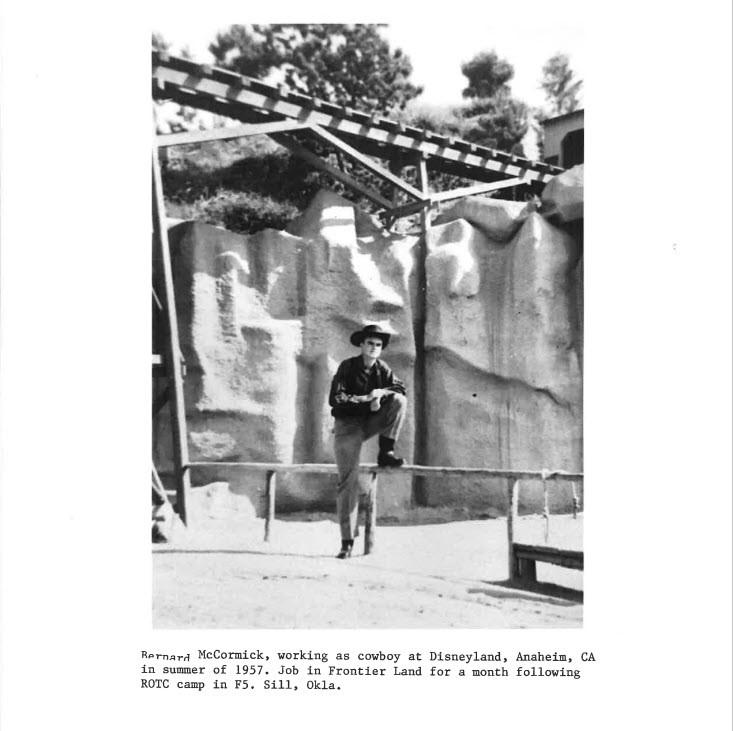
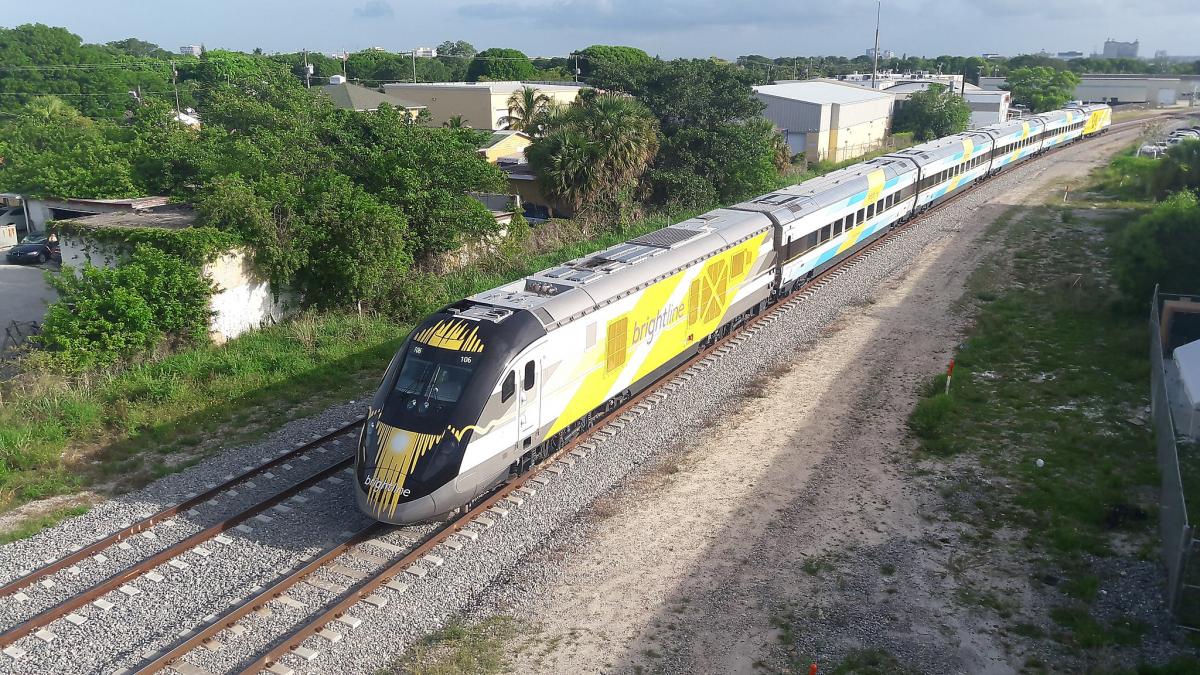
(Photo by BBT609, CC BY 2.0 <https://creativecommons.org/licenses/by/2.0>, via Wikimedia Commons)
For those who have not yet ridden Brightline between Miami and West Palm Beach, you should know that it compares with the best fast trains in the world. It is attractive, extremely comfortable and smooth-riding, and perfectly situated to serve a large market. It has only one problem. It is dangerous as hell.
Not dangerous for the passengers. In four years there have been no injuries to riders. The danger is to those outside the train, to those in vehicles and on foot who have to deal with the lethal combination of high speed and numerous street grade crossings along its 65-mile route. It has quickly established itself as the most accident-unfriendly railroad in the country. It is first among 800 railroads in fatalities in its brief lifetime, five already since it recently resumed service after a long pandemic suspension.
This is not Brightline's fault. The Florida East Coast Railway (FEC) tracks have not had any passenger traffic since the 1960s, and even then it was only a few trains a day — nothing to compare to the busy Brightline schedule. Brightline is a modern concept, a combination of commuter line and intercity express with limited stops. Such trains are popping up around the country, often complementing long distance Amtrak trains. They need to be fast.
At the moment, Brightline's northern terminus is West Palm Beach, but an extension up the coast through Martin, St. Lucie, and Indian River counties is planned, connecting with a new rail line from Cocoa Beach to Orlando. When operational, it will be a huge asset for South Florida, serving both tourists and residents who will be able to commute to jobs in Fort Lauderdale from as far away as Stuart and Vero Beach.
Because there were no fast trains on its tracks until recently, the FEC permitted numerous grade crossings as South Florida grew over the years. With only slow moving freights, the grade crossings were a nuisance, holding up traffic for long minutes, but not a serious danger. Brightline changed that and the hazard will continue until the inevitable is faced — the railroad needs to be rebuilt. That job will take years, just as it took years for the problem to develop.
Right now the effort seems to be to make the crossing gates impenetrable to impatient motorists who routinely get around them or stupidly let themselves be stuck on the tracks in traffic jams when the bells start warning of the approaching train. Unlike northeastern railroads with extensive commuter train networks, Brightline does not have to deal with undulating terrain either elevating tracks or lowering them in ditches, both of which require numerous bridges. That was done 100 years ago on northeast rail lines.
The process could begin by closing off lesser used road crossings, and by taking advantage of sections of track that already have few or no crossings, and which could permit higher speeds than the current 79 miles per hour. That is standard for passenger trains around the country. It might be feasible to slow trains down to perhaps 55 or 60 miles per hour in the busy downtowns, and make up that time elsewhere.
An example of a possible speed-up zone is the two-mile stretch in south Fort Lauderdale from I-84 to Griffin Road, past the airport, where there are no nearby residential neighborhoods or grade crossings. In north Broward, the grade crossings are farther apart, and bridging at several key crossings could open up almost five miles of track entering Boca Raton. There are other sections at the Broward-Dade County line that are industrial and have few crossings. Some of the Brightline fatalities are obviously people who mindlessly enter the tracks. It would require serious fencing to keep such people off the rails, but it should permit trains to match speeds (approximately 125 miles per hour) planned for the new Orlando extension. Bridges in downtown Fort Lauderdale and Miami would be complicated and disruptive, dealing with larger buildings at the busy intersections. Not so to the north where only light industry would be affected by the construction.
Ben Porritt, Brightline’s senior vice president for corporate affairs, says Brightline and the FEC would both like to reduce the number of grade crossings, but it can be a cumbersome process involving public input and approval at several levels of government.
It seems more expedient to bridge some crossings. Compared to the cost of building an entirely new elevated railroad from Cocoa Beach to Orlando, strategically placed bridges would not seem a great expense, while achieving the dual goals of reducing the accidents and enabling higher speeds at the same time. Such a program could start quickly, and gradually turn the FEC into a first-class high-speed corridor.
It may take some years, but Rome wasn’t built in a day. Neither was the FEC.
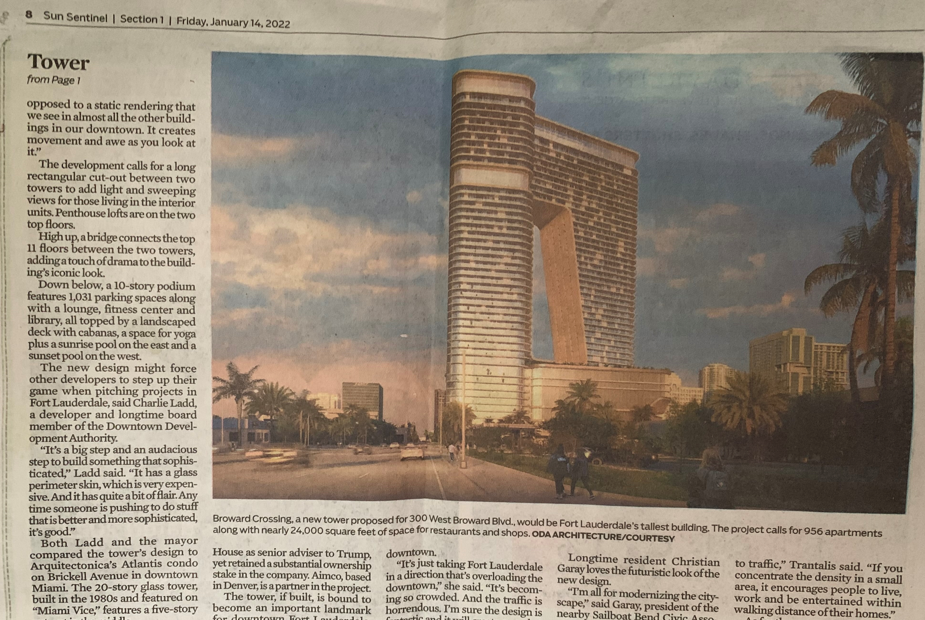
Coverage of Broward Crossing in Sun Sentinel's January 14, 2022 edition
Our recent blog on the wall-to-wall development being permitted in downtown Fort Lauderdale appeared a day too soon. Almost on cue, the Sun Sentinel reported on a proposal for the tallest condominium in the city, located just west of the Brightline station on Broward Boulevard. The novel modern design would provide for 1,000 new units.
In describing the 47-story structure, to be known as Broward Crossing, the paper illustrated the divide between the city officials' attitude toward growth, and the thinking of people who have to deal with the consequences of the seemingly endless parade of cranes signaling tall new buildings. Nobody questions the location. It is within a short walk of the commuter train.
"It's very dramatic," Mayor Dean Trantalis said. "It's dramatic in form and shape as opposed to a static rendering that we see in almost all the other buildings in our downtown. It creates movement and awe as you look at it."
Commissioner Steve Glassman, who represents the district where the building would rise, also sounded enthusiastic. "My first impression was ‘Wow,’" Glassman is quoted. "I thought the architecture was really cool. We have several cool buildings downtown, but we have too many boxes. This design really does make a statement for Broward Boulevard as a gateway for people heading into the city from the west."
Charlie Ladd, a developer and board member of the Downtown Development Authority, thought the design's flair would inspire other developers to be more creative in their designs. But none of those individuals mentioned the impact of all those new units on those of us already living here. To the contrary, some of their quotes sounded as if they were written by the developer's PR firm.
Christian Garay, president of the Sailboat Bend Civic Association, praised the design and added that he has friends in real estate who tell him the city needs more high-rise towers. "Now more than ever you're seeing a lack of available properties out there, both commercial and residential," he said. "There's not enough properties on the market to keep up with demand. The city needs to progress. And buildings like this show progress.”
Charlie Ladd concurred, and responded to people who said the new building was just too much. His comment: "Last I heard they don't have cities in the United States where they say, ‘No one else can come here.’ Builders will stop building when people stop filling up the buildings."
He said current high rises are full and the city needs to facilitate new development. The comment seems doubtful to anyone who has seen buildings at night with few lights on suggesting occupancy.
As far as cities that don’t welcome newcomers, you don’t have to go very far to find Florida communities which don’t want many newcomers. Stuart and Vero Beach, for instance, in the 1970s passed height limitations (about four stories) to prevent what they saw going on to the south. And this was before Fort Lauderdale’s downtown took off. Fort Lauderdale’s one tall building was nine floors. It was rather a reaction to wall-to-wall high rises along the beaches of Dade and Broward counties.
Fort Lauderdale was — and still is — used as an example of what these cities don’t want to become. And it is no coincidence that both Vero and Stuart are filled with people who fled South Florida to return to an unhurried lifestyle that attracted them in the first place.
The irony of the opposition to the proposed latest big building is that the site just west of the railroad could use development. It is a perfect location for a nice four-story office building which would attract commuters using the convenience of Brightline from up and down the coast, and be gone after work, rather than new residents who would rarely use the train but add their cars to the worsening traffic mess.
The Sun Sentinel recently had several editorials regarding the seemingly unbridled growth being permitted in downtown Fort Lauderdale. One piece dealt with the proposal to put condos in Bahia Mar. The paper urged the city commission to be careful about approving any plan that hurts the annual boat show, and isn't the best deal for taxpayers. Another story dealt with a proposal to build a condo along the New River that is opposed by residents as too tall for its location among much smaller buildings. The idea even has opposition from the Rio Vista neighborhood on the other side of the river. Residents think a trend toward tall buildings so close affects their own low rise quality of life.
The feeling here is the city should approve all new buildings, no matter how tall or ugly, as long as the people who buy in those buildings are not permitted to drive cars. It seems that in approving so much tall construction over the last decade, the city ignores the traffic they generate that compromises the quality of life of the older, increasingly attractive neighborhoods on the edge of downtown.
In one of its pieces, the paper asked the question that residents have been asking with each new skyscraper: Why do people who almost always run on controlled growth platforms readily approve exactly the opposite when they take office? Developers always say how their projects enhance their neighborhoods by bringing in new business and taxpayers. They never mention the negatives, which include the possibility that access to their buildings could be underwater in a few years, to say nothing of the traffic messes they create.
The latter gridlock is already bad, and will only get worse when (and if) all that new construction is occupied. There are complaints all over Broward County, but the worst problem seems to be getting people from downtown to the beach. The most used route is the biggest problem. Most traffic between the beach, downtown, and western Broward is on Broward Boulevard, which links to Las Olas Boulevard and then on to the heart of beach activity. The problem is that link.
Broward and Las Olas are both four lanes, but Broward ends at Victoria Park. The only way to Las Olas is three blocks of narrow, two-lane residential streets through the old neighborhood called Colee Hammock. The city over the years has made 15th Avenue the primary connection, and it simply can't handle the increasing volume of traffic. During busy hours, vehicles line up for blocks on Broward and Las Olas as drivers wait to make the turn onto 15th. As a result, impatient drivers cut through other streets, some of which are notable for their abundant heritage oaks and well-preserved older homes, and are favored by people walking dogs and pushing baby carriages.
The only solution advanced recently is the exotic Elon Musk tunnel from the Brightline Station on Broward all the way to the beach. But because its two lanes will only accommodate special vehicles and not ordinary traffic, it will not come close to solving the problem. Commuters still need their cars at either end of the tunnel. The only people who would use it are tourists who don't need cars, and they aren't the cause of gridlock.
The impractical tunnel idea, however, leads to a more practical one. Why not a real tunnel, such as the Henry Kinney Tunnel under the New River? It need not be an enormously expensive tunnel all the way from the Brightline location to the beach. It could be just long enough to connect Broward Blvd. to Las Olas, following the present traffic jam corridor from 15th and Broward over to Las Olas and then a few blocks toward the beach, coming up where the Las Olas Isles begin. It would be a challenge to build it along Broward, but no more so than it was to build the entrances to the New River Tunnel on U.S. 1 years ago. The access on Las Olas would be easier as there is a median which provides plenty of room.
Now that would solve the problem, at least as it exists today. In the long run, if all the tall new buildings under construction are ever filled with office workers and residents, it is hard to imagine any solution to the avalanche of traffic that will follow. Perhaps city planners and commissioners will give that prospect some thought the next time they are asked to approve buildings that are simply too big for this city.
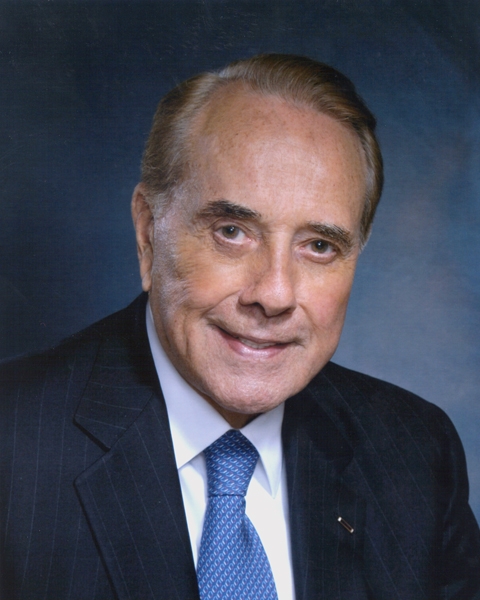
It was the summer of 1996 and Senator Bob Dole was running for president. Some thought he was not a strong candidate, despite his well-known war record and years of experience in Washington, because he was not a show horse and not as known to the public as some other senior senators. I was inclined to make him the second Republican I voted for for president (there was also one independent). His opponent was incumbent President Bill Clinton, who always rubbed me the wrong way. I had chuckled in approval when, following the 1996 election, ABC's David Brinkley said that Clinton "has not a creative bone in his body."
And so it came to pass that candidate Dole came to Fort Lauderdale for a reception sponsored by the Republican Party. It was at a beach hotel, and Mark McCormick, somewhat active in the party at the time, was invited, and he brought along his dad. We arrived a bit early and were surprised to find Senator Dole almost alone. What was immediately apparent was his handicap from his WWII wound in Italy. He quickly extended his left hand to shake, while his right hung uselessly by his side.
He must have asked Mark what he did, and Mark said he was just finishing six years in the Navy. Dole asked about his service, and they chatted for several minutes about Mark having been navigator of a fast frigate, and then teaching at the Navy Surface War School in Newport, R.I. The room was filling quickly, and as others approached him, Dole continued to show interest in Mark's background. Soon he turned to the work of the night and there followed two hours of greeting strangers and listening to speeches. By the end of the night he must have met hundreds, maybe a thousand people, most of whom were strangers.
We did not plan it that way, but as we headed for the door we chanced to see Dole again. This time he was surrounded by people, but to our amazement, he noticed Mark and made another comment about his Navy time. I have met a lot of politicians over the years, and even though some of them are good at names, we doubt many of them meeting so many people at a reception would remember someone five minutes later, much less resume a conversation from several hours before. Needless to say, he got our votes.
It wasn't enough, but as was apparent in the memorial service for him Thursday, Bob Dole has gone down as an all-round patriot, an admired war veteran, a legislator known for his integrity who got along and was respected by people on both sides of the aisle, and a man who put service above self.
One could not help but contrast this dominant Republican from what seems a distant era with the dominant Republican today — the latter a draft dodger who doesn't begin to know the meaning of integrity, who seems more at home with our nation's enemies than his own people, and who places himself above all others, living and dead. And despite his glaring abuses, continues to enjoy the support of many members of his own Republican party who are as dishonest as he, or too gutless to disown him.
Photo Credit: President's Commission on Care for American's Returning Wounded Warriors (PCCWW), Public domain, via Wikimedia Commons
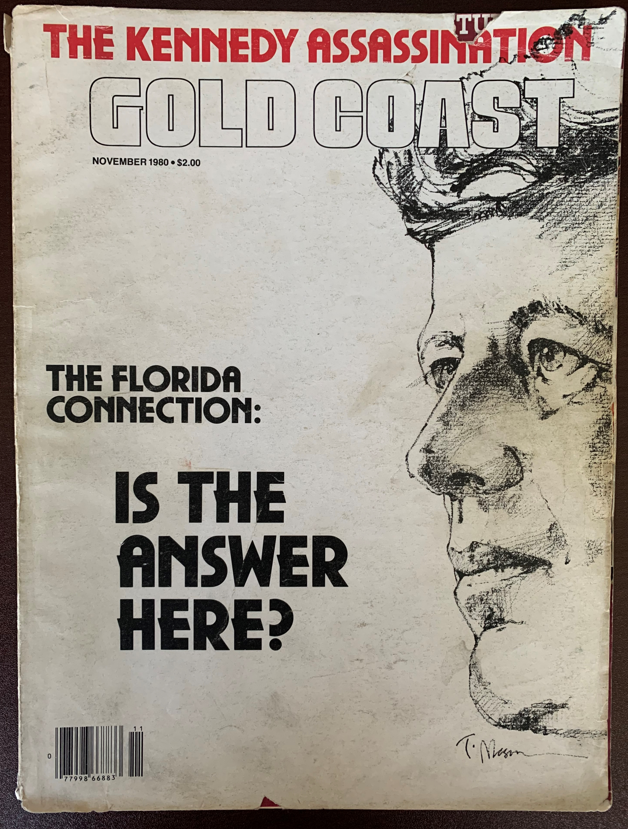
Gaeton Fonzi's first piece on the JFK assassination appeared in the November 1980 issue of Gold Coast.
"Don't you see it, boys? Don't you see it? There's only one outfit who could have pulled this off."
It has been 56 years, but you can still hear the gravelly voice of Vince Salandria in a motel room in Wildwood, New Jersey, telling Gaeton Fonzi and me that he was convinced the CIA had murdered President John F. Kennedy. The Warren Commission had been recently released, assuring us that Lee Harvey Oswald was a lone assassin. The report had been widely praised, but the problem was that those who praised it hadn't read it. They had just seen a summary. Almost nobody had taken the time to examine the 26 volumes of evidence supporting its conclusion.
Vince Salandria, a Philadelphia school board lawyer, had read the full report, and over the course of an hour he had pointed out the glaring inconsistencies which made it obvious that more than one shooter had been at work that day in Dallas. Salandria, a chronic mistruster of government, had sensed a CIA hit, especially when Oswald was crudely eliminated in a police station after proclaiming his innocence. This was long before researchers had found evidence that Oswald was an intelligence operative who had been set up to take the blame for the murder. The CIA connection has come out in bits and pieces over the decades — most recently last week — more on that later. And one of those researchers, and the man who uncovered the most damning connection to the CIA, was Gaeton Fonzi. He wrote some of the first articles challenging the Warren report for Philadelphia magazine.
He was no ordinary critic. Pennsylvania Senator Richard Schweiker, who recalled his stories in Philadelphia, hired him when he headed one of the committees that reopened the JFK probe in the mid-1970s. Schweiker shared Vince Salandria's view, describing Oswald as having "the fingerprints of intelligence all over him." He wanted Fonzi to look into the CIA's relationship to the anti-Castro movement in Florida and Oswald’s connections to that group.
Over several years Fonzi had access to government information that no other researchers enjoyed. It eventually led him to Antonio Veciana, who headed Alpha 66 — the most active Cuban American group trying to kill Castro. Before Veciana even learned what Fonzi's real mission was, he made the startling revelation that he had seen Oswald in the company of his CIA handler, a man who had risen to one of the high ranking jobs in the agency, shortly before the November 1963 hit on Kennedy.

Fonzi's 1993 book, The Last Investigation
Fonzi's magazine pieces ran over three issues in Gold Coast in 1980, and after considerable additional research, appeared in book form in 1993. The Last Investigation has undergone two reprints. In its 443 pages of text and nine pages of fine print footnotes, Fonzi revealed how the CIA operatives, both Cuban and American, sabotaged his work with false leads which wasted his time. Political figures friendly to the agency also impeded his committee's work, especially when it attempted to get cooperation from the CIA, and ultimately shut it down for lack of funding. But Fonzi realized that his anti-Castro contacts seemed to know stuff about Oswald and the assassination that they only hinted about. And most approved of Kennedy's murder as just retribution for his not using our military to save the disastrous 1961 Bay of Pigs invasion. Despite these obstacles, the committee’s final report, which was largely written by Fonzi, concluded that Kennedy’s death was not the work of a lone gunman, but a conspiracy. By whom was not included.
Which brings us to two weeks ago when the Miami Herald ran a story about Ricardo Morales, one of Veciana's allies in the Alpha 66 organization. He was mentioned in Fonzi's book. Morales’ son said his father told him and his brother late in his life that Oswald was one of the men he gave rifle sniper training to for the CIA. He did not think Oswald killed President Kennedy. He also said that two days before the assassination, his CIA handler sent him to Dallas to await a mission, and brought him back after the assassination. He thought he was part of a "clean-up" team in case they were needed. They were not. He also said he feared for his life because he knew too much about the CIA nefarious activities. That statement echoed what Veciana told Gaeton Fonzi in the 1970s when asked why he kept his explosive information quiet for more than 10 years. He said his goal was to eliminate Castro and did not want to alienate his CIA supporters. Also, he said if they murdered the President of the United States, why would they hesitate to silence him?
Ricardo Morales’ story would not have surprised Fonzi, who died in 2012. His book mentions others who told similar stories about going to Dallas for a mission they were never asked to perform.
The same Herald piece noted that President Biden recently joined a series of presidents to postpone declassifying the remaining 15,000 pages of documents pertaining to the assassination. According to the Herald, the stated reason: The need to protect "against identifiable harm to the military defense, intelligence operations, law enforcement, or the conduct of foreign relations that is of such gravity that it outweighs the public interest in immediate disclosure."
Isn't that some statement? Fifty-eight years after a president is murdered, revealing all the government knows about it will endanger national interests. That admission is that some government force that existed in 1963 is still operating. Those few — those dwindling few who have followed this case from the beginning — think that at the very least those documents will show Oswald's connection to the CIA and suggest decades of efforts by our government to conceal the fact that its lesser angels murdered a president.
Don't you see it, boys, don't you see it?
